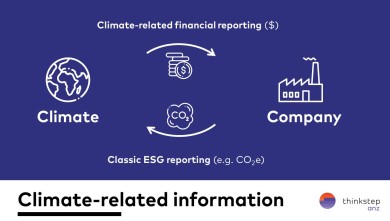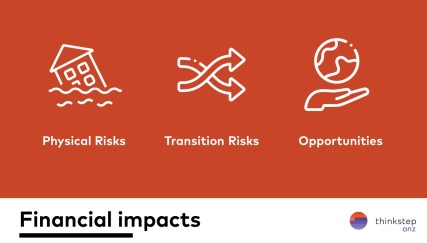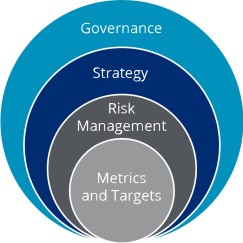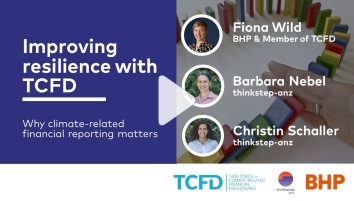Please note:
The Task Force for Climate-related Financial Disclosures (TCFD) has completed its work. The International Sustainability Standards Board (ISSB) now oversees climate-related financial disclosures. We still use TCFD as shorthand for climate-related disclosures as many people are familiar with this term.
 When we think about climate change, we often just visualise our impact on climate change and not necessarily the impact climate change will have on us. In reality, climate change presents real financial risks to the global economy, and consequently to actors in the global economy such as New Zealand and the manufacturing sector.
When we think about climate change, we often just visualise our impact on climate change and not necessarily the impact climate change will have on us. In reality, climate change presents real financial risks to the global economy, and consequently to actors in the global economy such as New Zealand and the manufacturing sector.
 Widely regarded as international best practice, the Task Force on Climate-related Financial Disclosures (TCFD) developed recommendations for businesses on how to assess and report on climate-related financial risks and opportunities. The market driven Task Force was launched in 2015 to develop a set of recommendations for voluntary and consistent climate-related financial risk disclosures. The recommendations enable companies to communicate information in a consistent format to investors, lenders, insurers, and other stakeholders. This information includes the risks and opportunities presented by climate change, climate-related policies, and emerging technologies.
Widely regarded as international best practice, the Task Force on Climate-related Financial Disclosures (TCFD) developed recommendations for businesses on how to assess and report on climate-related financial risks and opportunities. The market driven Task Force was launched in 2015 to develop a set of recommendations for voluntary and consistent climate-related financial risk disclosures. The recommendations enable companies to communicate information in a consistent format to investors, lenders, insurers, and other stakeholders. This information includes the risks and opportunities presented by climate change, climate-related policies, and emerging technologies.
Significance for New Zealand
Governments around the world are increasingly looking at making climate-related financial risk reporting mandatory. Based on the TCFD framework, New Zealand’s climate-related risk reporting regime, could be in effect as early as 2023 if approved in Parliament. The Government’s announcement signifies the growing importance of climate-related risk reporting from a compliance perspective for the financial sector. However, TCFD has benefits that extend beyond compliance and finance. In fact, TCFD has the essential role of building climate resiliency for businesses across all sectors including the manufacturing sector moving forward.
Building resilience
Disclosing climate-related information will help investors, insurers, and lenders to make informed decisions on capital allocation. Companies that are better prepared for climate risks and opportunities and transparently disclose this information will be inherently more attractive to investors. But how do you prepare for climate impacts and how do you report on them?
 The first step is to understand what financial impacts climate change has on a business and its supply chain. Climate-related risks can be physical risks, such as extreme weather events or transition risks which arise from changes in demand due to the transition to a low carbon economy. It is important not to forget about climate-related opportunities. For example, climate change can be an opportunity for companies that are developing low carbon technologies or investing in energy efficient alternatives.
The first step is to understand what financial impacts climate change has on a business and its supply chain. Climate-related risks can be physical risks, such as extreme weather events or transition risks which arise from changes in demand due to the transition to a low carbon economy. It is important not to forget about climate-related opportunities. For example, climate change can be an opportunity for companies that are developing low carbon technologies or investing in energy efficient alternatives.
The identification of climate risks and opportunities is the first step in getting started. In order to build long-term resilience, it is important to look beyond identification by assessing financial impacts, managing and integrating them into a company’s governance and structure.
TCFD not only provides a framework for reporting on climate risks and opportunities but also provides guidance on how to go about identifying, assessing, and managing them for companies across all sectors including manufacturing. TCFD is gaining traction in Australasia with a growing list of manufacturers such as BlueScope, Asaleo Care, and Fisher & Paykel Healthcare starting to integrate TCFD recommendations into their businesses. In fact, an encouraging picture is emerging of manufacturing around the world in its adoption of TCFD.
In the manufacturing sector
 Globally, manufacturing is setting the bar for climate-related disclosures. Released in October, the TCFD 2020 Status Report confirmed that materials and buildings companies, including manufacturing areas such as construction materials, and metals and mining, are leading on disclosure.
Globally, manufacturing is setting the bar for climate-related disclosures. Released in October, the TCFD 2020 Status Report confirmed that materials and buildings companies, including manufacturing areas such as construction materials, and metals and mining, are leading on disclosure.
Compared to other industries, the TCFD report found that materials and buildings had the highest percentage of companies disclosing information on climate-related metrics and Scope 1, 2 & 3 GHG emissions. Within the industry, other strong areas of disclosure were the risks and opportunities themselves, their impacts on organisations, and climate-related targets. Disclosure areas that still require improvement for materials and buildings companies include resiliency of strategy and integration of climate risks and opportunities into overall risk management.
In New Zealand, the manufacturing sector has the opportunity to lead by example as a significant contributor to the New Zealand economy. Manufacturing in NZ has maintained a contribution to GDP of about 11 per cent since 2013, comparable to the levels in the US, Canada, and Europe. The manufacturing sector also features strong inter-industry dependence, with the construction sector being strongly reliant on the output of the manufacturing sector domestically. As a significant contributor to NZ’s economy, picking up the pace will allow manufacturing to become better equipped as a sector for the impacts of climate change. Furthermore, the manufacturing sector’s relationship with other domestic industries will help to accelerate the adoption of TCFD reporting across New Zealand. As with anything else, the most important thing is to get started.
Getting started
Disclosure is a process; it is better to take the first step proactively rather than wait to act until everything is perfectly aligned. Dr Fiona Wild, a member of the Task Force and BHP’s Vice President of Sustainability & Climate Change, shares the same view in thinkstep-anz’s recent TCFD webinar: “just get started – it doesn’t have to be perfect the first time around!”.
 Companies can choose to disclose how far they currently align with TCFD and how they plan to close gaps. While the nature of climate-related financial risks is different to most risks covered in a company’s enterprise risk management, it is helpful to take the latter as it exists for most companies and start by adding the climate lens on. In fact, the core elements of TCFD—governance, strategy, risk management, and metrics & targets—should be familiar as they are a part of the existing structure of most companies. This shows that TCFD does not want to reinvent the wheel but want companies to build on existing structures and processes that they may already be covering climate-related risks and opportunities.
Companies can choose to disclose how far they currently align with TCFD and how they plan to close gaps. While the nature of climate-related financial risks is different to most risks covered in a company’s enterprise risk management, it is helpful to take the latter as it exists for most companies and start by adding the climate lens on. In fact, the core elements of TCFD—governance, strategy, risk management, and metrics & targets—should be familiar as they are a part of the existing structure of most companies. This shows that TCFD does not want to reinvent the wheel but want companies to build on existing structures and processes that they may already be covering climate-related risks and opportunities.
By Barbara Nebel and Christin Schaller
This article was first published in NZ Manufacturer magazine, November 2020.